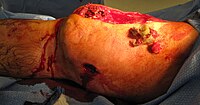
Photo from wikipedia
Introduction Motor vehicle crashes are common causes of blunt abdominal trauma in the 21st century. While splenic trauma occurs very frequently and thus there is a well-established treatment paradigm, traumatic… Click to show full abstract
Introduction Motor vehicle crashes are common causes of blunt abdominal trauma in the 21st century. While splenic trauma occurs very frequently and thus there is a well-established treatment paradigm, traumatic pancreatic injuries are relatively infrequent, occurring in only 3–5% of traumas. This low incidence means physicians have reduced experience with this condition and there is still ongoing debate with regards to the best practice in managing pancreatic trauma. During severe trauma, the pancreas can be injured as a consequence of blunt and penetrating injury. This has an estimated mortality rate ranging from 9 to 34%. Methods A systematic review was performed using three scientific databases: Embase, Medline and Cochrane and in-line with the PRISMA statement. We included only articles published in English, available as full text and describing only adults. Keywords included: pancrea*, trauma, blunt, operative management and non-operative management. Results Three studies were found that directly compared operative versus non-operative management in blunt pancreatic trauma. Length of stay, mortality and rate of re-intervention were lower in the non-operative group compared to the operative group. However, the average grade of pancreatic injury was lower in the non-operative group compared to the operative group. Discussion Our results revealed that patients who undergo non-operative management tend to have lower grade of injuries and patients with higher grade of injury tend to be managed in an operative fashion. This could be likely due to the fact that higher grade of pancreatic injuries is often accompanied by other injuries such as hollow viscus injury and therefore require operative intervention. Conclusion Non-operative management is a safe approach for low-grade blunt pancreatic trauma without ductal injuries. However, more evidence is required to improve our understanding and treatment plans. We suggest a large international multicentre study combining data from multiple international trauma centres to collect adequate data.
Journal Title: Trauma
Year Published: 2019
Link to full text (if available)
Share on Social Media: Sign Up to like & get
recommendations!